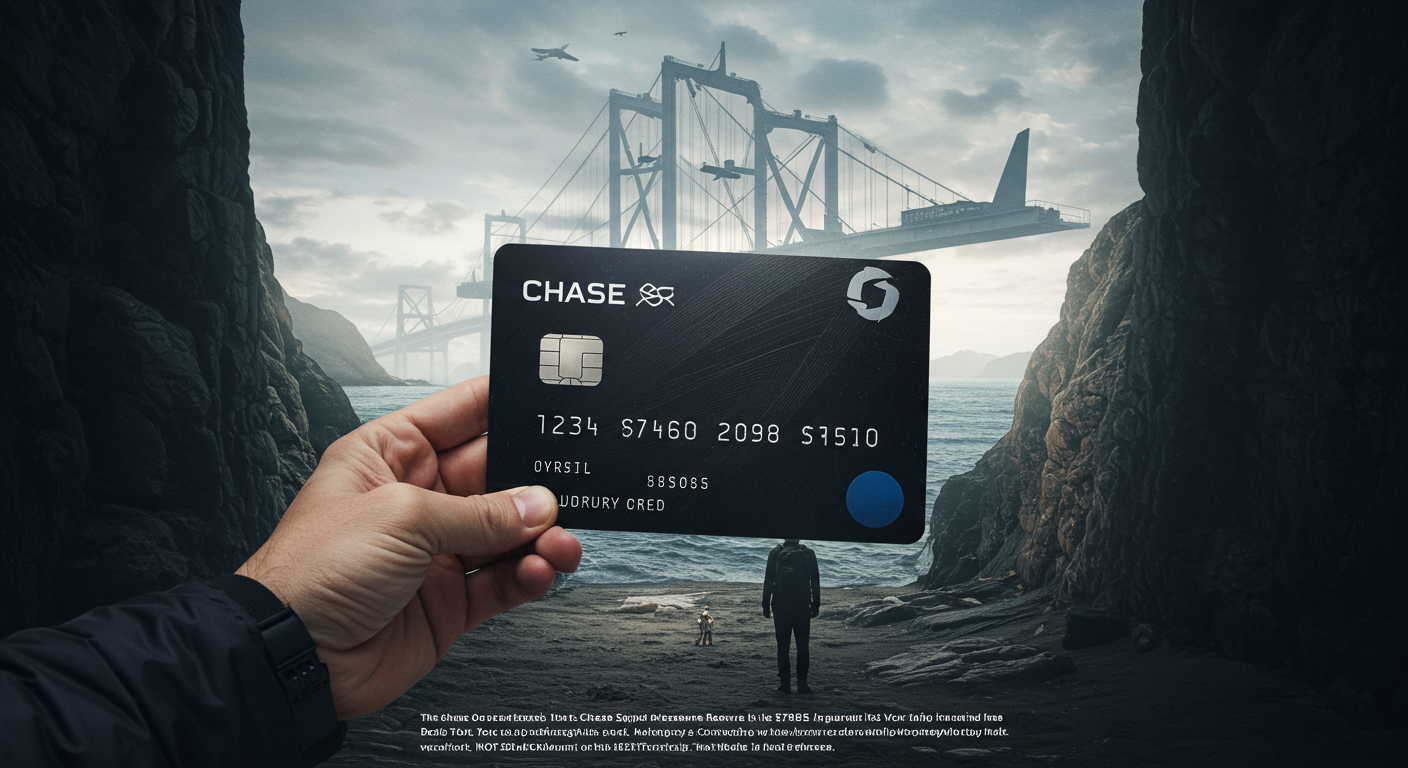The Chase Sapphire Reserve. For many, the name evokes images of premium travel, exclusive perks, and a certain cachet. But with a hefty $795 annual fee, a crucial question arises: is this card a savvy financial tool, a genuine investment in your travel lifestyle, or is it merely an expensive luxury trap? This article will dissect the Chase Sapphire Reserve, helping you determine if its impressive suite of benefits justifies its significant cost for your specific financial situation and travel habits.
Understanding the Chase Sapphire Reserve: More Than Just a Card
The Chase Sapphire Reserve isn’t your average credit card. It’s positioned as a premium travel rewards card, designed for individuals who travel frequently and spend significantly in categories like dining and travel. Its value proposition hinges on earning valuable points and accessing a range of benefits that enhance the travel experience and offer peace of mind. Before you can decide if it’s right for you, it’s essential to understand what you’re getting – and what you’re paying for.
The Elephant in the Room: That $795 Annual Fee
Let’s address it head-on: the $795 annual fee is substantial. This figure alone can be a barrier for many, and rightly so. No one wants to pay such a high fee unless the tangible value received clearly outweighs the cost. The key is to look beyond this initial sticker shock and meticulously evaluate whether the card’s benefits will actively work for you, effectively reducing that net cost and providing surplus value. This evaluation requires a close look at your spending habits, travel patterns, and how you’d utilize each specific perk offered.

Unlocking Value: The Core Benefits of the Chase Sapphire Reserve
To determine if the Chase Sapphire Reserve is a worthwhile addition to your wallet, you need to understand its core benefits. These are the primary ways cardholders can extract value and potentially offset that significant annual fee.
Earning Powerful Rewards
One of the main attractions of the Chase Sapphire Reserve is its rewards earning potential, primarily through Chase Ultimate Rewards points. Typically, you can expect to earn points at an accelerated rate on specific categories. These often include:
- Travel: This can encompass a wide range of purchases, from flights and hotels to car rentals and cruises, often after the first $300 is spent on travel annually (which is covered by the travel credit).
- Dining: Restaurants, cafes, and even some delivery services usually qualify for bonus points.
- All other purchases typically earn a standard rate, like one point per dollar spent.
The more you spend in these bonus categories, the faster your points accumulate, directly impacting the card’s overall value to you.
Redeeming for Maximum Impact
Earning points is only half the equation; redeeming them effectively is crucial. With Ultimate Rewards points earned via the Sapphire Reserve, you generally have several redemption options:
- Chase Travel℠ Portal: Points often have an increased value when redeemed for travel (flights, hotels, car rentals, etc.) through Chase’s own travel portal. For example, points might be worth 50% more, meaning 10,000 points could get you $150 worth of travel.
- Transfer to Airline and Hotel Partners: This is often where the highest potential value lies. Chase partners with a variety of airline and hotel loyalty programs. By transferring points, often on a 1:1 basis, you can book premium cabin flights or luxury hotel stays that might offer outsized value compared to cash prices or portal redemptions. Strategic transfers require some research but can yield significant returns.
- Cash Back or Statement Credits: While an option, this typically provides a lower value per point (e.g., 1 cent per point) compared to travel redemptions.
- Other options: Gift cards and merchandise are also usually available, but like cash back, may not offer the best value.
The Coveted $300 Annual Travel Credit
Perhaps the most straightforward benefit that helps offset the annual fee is the $300 annual travel credit. This is typically applied automatically as a statement credit for travel purchases charged to your card, up to $300 per account anniversary year. This effectively reduces the annual fee’s hit to $495 ($795 – $300) if you spend at least $300 on travel annually, which most people considering this card likely will. Ensure you understand what qualifies as a travel purchase for this credit, as it’s usually quite broad, including airfare, hotels, public transport, and even parking fees.
Beyond Points and Credits: Premium Travel Perks
The Chase Sapphire Reserve’s appeal extends beyond just points and statement credits. It offers a suite of travel perks designed to make your journeys smoother, more comfortable, and more secure.
Airport Lounge Access
A significant perk for frequent flyers is complimentary Priority Pass Select membership. This grants you and authorized users access to over 1,300 airport lounges worldwide. Lounges offer a quieter space to relax, work, and enjoy complimentary refreshments and Wi-Fi, which can be invaluable during long layovers or delays. Calculate the value of this benefit based on how often you’d realistically use airport lounges and what you’d otherwise pay for access or amenities.
Comprehensive Travel and Purchase Protections
This is an area where premium cards like the Chase Sapphire Reserve truly shine, offering a safety net that can save you significant money and hassle. Common protections include:
- Trip Cancellation/Interruption Insurance: Reimburses you for prepaid, non-refundable travel expenses if your trip is canceled or cut short due to covered reasons.
- Auto Rental Collision Damage Waiver: Provides primary coverage for damage due to collision or theft for most rental cars when you decline the rental company’s insurance and charge the entire rental cost to your card.
- Lost Luggage Reimbursement: Covers you if your checked or carry-on baggage is lost or damaged by the carrier.
- Baggage Delay Insurance: Reimburses essential purchases if your baggage is delayed.
- Purchase Protection: Covers new purchases against damage or theft for a certain period (e.g., 120 days).
- Extended Warranty Protection: Extends the manufacturer’s warranty on eligible items.
Review the terms and conditions for these protections carefully, as coverage limits and exclusions apply. The peace of mind and potential savings from these insurances can be substantial.
Additional Lifestyle Conveniences
The Chase Sapphire Reserve often comes bundled with other credits and benefits that can add further value, depending on your lifestyle. These might include statement credits for services like:
- Global Entry or TSA PreCheck application fee credit.
- Partnerships with food delivery services or rideshare companies, offering monthly or annual credits.
These perks can add up, but only if you actually use the services they cover.
Doing the Math: When Does the $795 Fee Make Sense?
The decision to get the Chase Sapphire Reserve ultimately comes down to a personal cost-benefit analysis. You need to honestly assess how much value you will derive from its benefits.
Calculating Your Personal Break-Even Point
To determine if the card is “worth it,” follow these steps:
- Subtract the $300 travel credit: If you spend at least $300 on travel annually, your effective annual fee becomes $495.
- Estimate the value of points earned: Based on your annual spending in bonus categories (travel and dining) and your typical redemption strategy (e.g., 1.5 cents per point via Chase Travel℠, or potentially more with transfer partners), calculate the dollar value of the rewards you’d earn.
- Assign a value to lounge access: If you travel frequently and would pay for lounge access or airport food/drinks, estimate this annual saving.
- Consider the value of other credits: If you’ll use Global Entry/TSA PreCheck or partner credits (like DoorDash, Lyft, if offered), add their value.
- Factor in travel insurances: While harder to quantify unless you make a claim, consider the potential savings and peace of mind. Would you pay for separate travel insurance otherwise?
If the total value of these benefits comfortably exceeds $495 (your effective annual fee after the travel credit), the card could be a good financial choice. Explore various Financial Products to see how this card compares to your overall financial strategy.
Factors that Tip the Scale Towards Value
The card tends to offer more value if you:
- Travel several times a year.
- Spend a significant amount on dining out and travel.
- Can maximize point redemptions through transfer partners or the Chase Travel℠ portal for increased value.
- Will regularly use the airport lounge access.
- Value the comprehensive travel and purchase protections.
Is the Chase Sapphire Reserve a Smart Investment for You?
Thinking of the Chase Sapphire Reserve as an investment means you expect a return greater than your initial outlay (the annual fee). The ideal cardholder is someone whose lifestyle and spending habits align perfectly with the card’s reward structure and benefits. You are likely a good candidate if you are a frequent traveler, a high spender in the card’s bonus categories (travel and dining), and someone who will diligently use the various credits and perks offered. You should also be comfortable managing a premium card and its features to extract maximum value, ensuring your personal savings goals are not compromised by the fee.
This card is built for those who see travel not just as a leisure activity but as a significant part of their lifestyle, and who are willing to engage with the rewards program to optimize redemptions. If you can consistently offset the annual fee through the travel credit and earn substantial rewards on top of that, while also enjoying the premium travel perks, then the $795 annual fee can indeed transform into a worthwhile expenditure.
Avoiding the Luxury Trap: When to Say No
The Chase Sapphire Reserve can become a luxury trap if its benefits don’t align with your actual habits or if the fee strains your budget. It’s not the right card for you if:
- You travel infrequently (e.g., once or twice a year).
- Your spending on travel and dining is low.
- You prefer straightforward cash back rewards without the complexity of travel portals or transfer partners.
- You won’t consistently use the $300 travel credit or other statement credits.
- Airport lounge access isn’t a priority for you.
- The $795 annual fee causes you financial stress or prevents you from meeting other financial goals, like building your savings.
- You are primarily attracted to the card for its status symbol rather than its tangible financial benefits.
In these scenarios, the high annual fee would likely outweigh the value you receive, making it an expensive accessory rather than a smart financial tool. Be honest with yourself about your usage patterns.
Considering Your Options: The Broader Financial Landscape
The Chase Sapphire Reserve is just one option in a vast market of Financial Products. If its high fee or travel focus doesn’t suit you, explore other avenues. There are many excellent travel rewards cards with lower annual fees that still offer valuable perks. Alternatively, a straightforward cash-back credit card might be more beneficial if your spending is varied or you prioritize simplicity. Assess your complete financial picture and spending habits before committing to any premium product. Understanding the current economy and your personal financial health is key when making such decisions.
Conclusion: Your Verdict on the Chase Sapphire Reserve
Ultimately, the decision of whether the Chase Sapphire Reserve and its $795 annual fee represent a smart investment or a luxury trap is deeply personal. It requires a thorough and honest assessment of your travel frequency, spending habits, and how effectively you can utilize its suite of premium benefits. For the road warrior who dines out often and strategically redeems points, the card can deliver exceptional value well beyond its cost. For the occasional traveler or modest spender, it might be an unnecessary expense.
Avoid the allure of prestige alone. Focus on the tangible returns. If the math works in your favor and the benefits genuinely enhance your lifestyle, the Chase Sapphire Reserve can be a powerful tool in your financial arsenal. If not, there are plenty of other excellent cards that may be a better fit for your needs.
Frequently Asked Questions (FAQ)
- Is the $300 travel credit easy to use?
- Generally, yes. The $300 annual travel credit on the Chase Sapphire Reserve is typically applied automatically as statement credits to your account after you make eligible travel purchases. The definition of “travel” is usually broad, covering expenses like flights, hotels, ride-sharing services, train tickets, and even parking. Most cardholders who travel even moderately find it straightforward to maximize this credit each year, effectively reducing the net annual fee.
- How much do I need to spend on travel and dining for the Chase Sapphire Reserve to be worth it?
- There’s no single magic number, as it depends on how you value the other perks like lounge access and travel protections, and how effectively you redeem your points. However, after accounting for the $300 travel credit (making the effective fee $495), you’d need to earn at least $495 in rewards value from your spending and other benefits. If points are worth 1.5 cents each when redeemed for travel, you’d need to earn roughly 33,000 points from spending. If you earn 3 points per dollar on travel and dining, this would mean spending around $11,000 in those categories annually *just to break even on the fee with points alone*. You must also factor in the value of lounge access and other credits/protections to get your full picture.
- What if I’m not sure I travel enough to justify the Chase Sapphire Reserve?
- If you’re uncertain, it’s wise to be cautious. Track your travel and dining spending for a few months. Realistically assess how often you’d use airport lounges or benefit from travel insurance. If your travel is infrequent or your spending in bonus categories is low, a card with a lower annual fee, or even a no-annual-fee travel or cash-back card, might be a more financially prudent choice. You can always upgrade to a premium card later if your travel habits change. Consider exploring other Financial Products that might better suit your current lifestyle.



